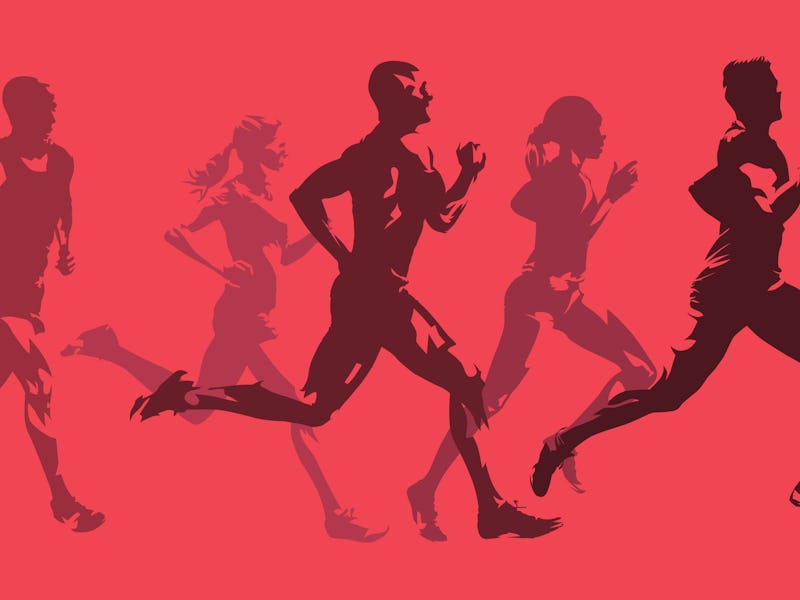Study of 14,000 runners reveals surprising link between elite athletes and beginners
Two simple measurements can accurately predict marathon performance, a new study suggests.

Wearable technology is redefining what it means to exercise. Whether using a running app on your smartphone to map your run, or wearing a Fitbit or smartwatch as you work out, these tech innovations spew data points our way, enabling the user to not only track their physical activity, but refine it to their utmost advantage.
The data are also useful for scientists. In a new study published Tuesday in Nature Communications, researchers used data from 1.6 million real runs to show how collecting basic metrics with a smartwatch can be used to accurately predict the pace of marathon runners. The data could also help novice joggers better understand — and improve — their performance.
Potentially a relic of our hunter-gatherer past, humans have pursued long-distance running for sport for centuries. But despite the sport's longevity, the researchers behind this new study say that mathematical models to accurately describe the mechanics and physiology of running are lacking. To fill the gap, the researchers turned to running data collected from wearables around the world.
The problem with collecting and using these data in studies of this kind, Thorsten Emig, the study's first author and theoretical physicist at the Université Paris-Saclay, tells Inverse, is that it is inherently messy. The data quality are variable and key details (like the weather, for example) are often missing.
"Most non-lab approaches are based on a single parameter, which is in almost all cases [is]... the maximum amount of oxygen that an athlete can consume per minute and body weight," Emig explains.
Because runners often have to guess at inputs for calculations done by their exercise wearables (for example, their maximum heart rate), Emig says these calculations can be inaccurate and may under or overestimate race-time predictions.
As a result, invasive laboratory tests remain the gold standard for accurately measuring important physiological parameters like oxygen consumption and maximal aerobic speed.
But because these analyses are done in a controlled environment, the results do not always transfer to the real-world. So to complement these lab analyses, Emig and his colleagues sourced running data from over 14,000 marathon runners collected over the course of 3.5 years to create a robust mathematical model that they say can accurately predict performance — even in unpredictable circumstances.
Not all wearable data is created equal, however. In this study, the researchers opted to use data from devices like the V800 Sports Watch of Polar Electro Oy (a GPS-enabled smartwatch often used by elite runners) instead of more common wearables, like Fitbits or Apple Watches. The data were uploaded to an analytical platform which the researchers then used to craft their model.
In total, the data included nearly 20 million miles (32 million kilometers) of running distance.
Predicting a marathon — Using these data, the researchers designed a mathematical model to measure two parameters — endurance and maximal aerobic speed — based only on distance and duration of any given run. Powered by the millions of data points, the model accurately predicted the runners' future marathon times with a mean error of only two percent, the study reveals.
But, despite these promising results, the researchers admit the model still has limitations. For example, because the model uses only duration and distance as the inputs, it would not take account of things like the difference between a slower, constant pace and a faster pace with moments of walking or stopping in between short bursts. As a result, the mean velocity predicted may be inaccurate.
Nevertheless, the researchers say their model can still be used to complement laboratory tests of pro athletes' performance. It may also be useful for beginners looking for insight into how their running regimes are affecting their performance.
"A runner who has completed some races on shorter distances, say 5km and 10km, could use our approach to estimate maximal aerobic speed and endurance, and from these two parameters get a good estimate for what to expect in a marathon race, and how to train for a marathon," Emig explains. "Other applications, for runners that like only shorter distances, would be tracking over time of the two model parameters and hence potential race performance or health status."
In the future, the researchers say such a model may even help identify talented athletes with the potential to go pro, or provide insights into how new sports equipment, like running shoe technology, affects performance.
Abstract: Wearable exercise trackers provide data that encode information on individual running performance. These data hold great potential for enhancing our understanding of the complex interplay between training and performance. Here we demonstrate feasibility of this idea by applying a previously validated mathematical model to real-world running activities of ≈ 14,000 individuals with ≈ 1.6 million exercise sessions containing duration and distance, with a total distance of ≈ 20 million km. Our model depends on two performance parameters: an aerobic power index and an endurance index. Inclusion of endurance, which describes the decline in sustainable power over duration, offers novel insights into performance: a highly accurate race time prediction and the identification of key parameters such as the lactate threshold, commonly used in exercise physiology. Correlations between performance indices and training volume and intensity are quantified, pointing to an optimal training. Our findings hint at new ways to quantify and predict athletic performance under real-world conditions.